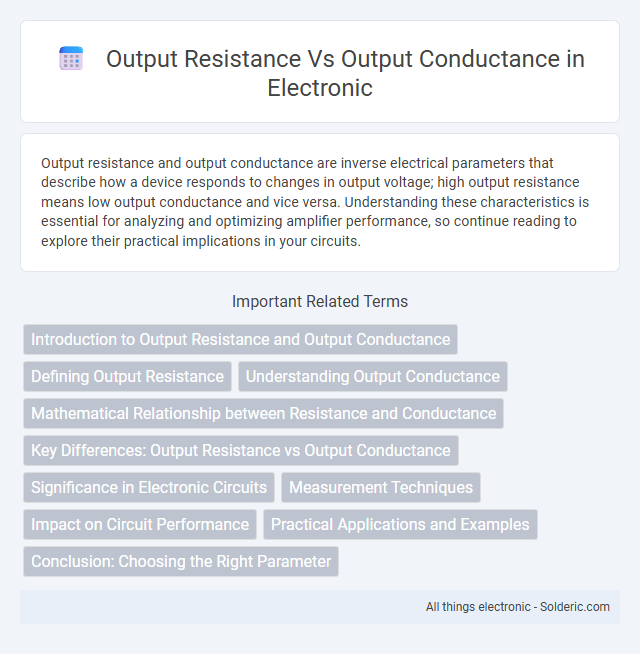Output resistance and output conductance are inverse electrical parameters that describe how a device responds to changes in output voltage; high output resistance means low output conductance and vice versa. Understanding these characteristics is essential for analyzing and optimizing amplifier performance, so continue reading to explore their practical implications in your circuits.
Comparison Table
| Parameter | Output Resistance (Rout) | Output Conductance (gout) |
|---|---|---|
| Definition | Measure of opposition to current flow at output terminal | Inverse of output resistance; measure of ease of current flow |
| Formula | Rout = DVout / DIout | gout = DIout / DVout = 1 / Rout |
| Unit | Ohms (O) | Siemens (S) or mhos |
| Physical Meaning | Higher Rout means less current leakage; desirable in amplifiers | Higher gout means more leakage current; generally undesirable |
| Typical Use | Evaluating amplifier output impedance | Analyzing device conductance behavior at output |
| Relation to Device Type | Important in field-effect transistors (FETs), BJTs | Used in small signal models to represent output characteristics |
Introduction to Output Resistance and Output Conductance
Output resistance quantifies the opposition a device offers to current flow at its output terminal, influencing voltage stability in amplifiers. Output conductance, the reciprocal of output resistance, measures the ease of current flow through the output, directly impacting the gain and linearity of electronic components. Understanding both parameters is crucial for designing efficient circuits with desired performance characteristics in transistors and operational amplifiers.
Defining Output Resistance
Output resistance, also known as output impedance, measures how much a device resists current flow at its output terminal, directly impacting voltage stability under varying load conditions. It quantifies the change in output voltage relative to changes in output current, often expressed as the ratio of voltage change to current change (DV/DI). Lower output resistance indicates better capability of maintaining voltage consistency, crucial in amplifiers and power supplies for optimal performance.
Understanding Output Conductance
Output conductance measures the change in output current relative to changes in output voltage, directly influencing an amplifier's gain stability. Lower output conductance indicates better current regulation, improving overall device performance and signal fidelity. Understanding output conductance helps you optimize circuit design for enhanced amplification and reduced distortion.
Mathematical Relationship between Resistance and Conductance
Output resistance (R_out) and output conductance (G_out) are mathematically related as reciprocals, where R_out = 1 / G_out and G_out = 1 / R_out. This relationship highlights that as output resistance increases, output conductance decreases proportionally, reflecting their inverse dependency in electrical circuits. Understanding this principle allows you to analyze and optimize transistor or amplifier performance efficiently by evaluating how changes in one parameter affect the other.
Key Differences: Output Resistance vs Output Conductance
Output resistance measures how much a device resists current flow at its output terminal, expressed in ohms, while output conductance quantifies the ease of current flow, being the reciprocal of output resistance and measured in siemens. Output resistance indicates how effectively a device can maintain voltage despite load changes, whereas output conductance reflects the sensitivity of output current to voltage variations. Your understanding of these parameters is crucial for designing circuits with desired stability and performance characteristics.
Significance in Electronic Circuits
In electronic circuits, output resistance determines how much a device influences the load voltage when delivering current, directly affecting voltage stability and power efficiency. Output conductance, the reciprocal of output resistance, indicates the device's ability to allow current flow under voltage changes, impacting signal amplification and linearity. Understanding your circuit's output resistance and conductance is crucial for optimizing performance, minimizing distortion, and ensuring reliable signal transmission.
Measurement Techniques
Output resistance is typically measured using a small-signal test where a known voltage perturbation is applied at the output terminal and the resulting change in current is recorded, while output conductance is derived as the inverse ratio of this change. You can measure output conductance by applying a voltage sweep and monitoring the incremental current, often using parameter analyzers or semiconductor curve tracers for precise characterization. Both techniques require careful control of biasing conditions to ensure accurate extraction of device parameters from the I-V characteristics.
Impact on Circuit Performance
Output resistance directly influences voltage gain and linearity in amplifier circuits, with higher resistance often leading to increased voltage gain but reduced stability. Output conductance, being the reciprocal of output resistance, affects the output impedance and power efficiency, where higher conductance can cause signal distortion and decreased gain accuracy. Optimizing the balance between output resistance and conductance is critical for achieving desired frequency response and minimizing signal degradation in high-performance electronic circuits.
Practical Applications and Examples
Output resistance and output conductance critically impact amplifier performance in practical applications such as audio amplifiers and transistor circuits, where low output resistance ensures better signal transfer and minimal distortion. In power amplifiers, output resistance affects load driving capability, while output conductance influences gain stability and linearity in field-effect transistors (FETs). You can optimize circuit efficiency by carefully selecting components with desired output resistance and conductance values to match specific use cases like sensor interfaces or RF amplifiers.
Conclusion: Choosing the Right Parameter
Output resistance and output conductance are inversely related parameters that indicate a device's ability to control output current with varying output voltage; selecting output resistance is ideal when emphasizing stability and minimal voltage variation effects, while output conductance is preferable for analyzing leakage currents and small-signal behavior. For high-gain amplifier design, minimizing output conductance ensures better linearity and reduced distortion, whereas maximizing output resistance contributes to improved voltage gain. Engineers should choose the parameter that aligns with their specific application needs, focusing on output resistance for voltage-driven analysis and output conductance for current-driven models.
Output resistance vs Output conductance Infographic

 solderic.com
solderic.com